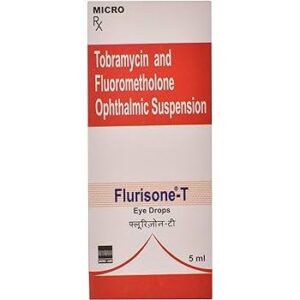TOBRAMYCIN + FLUOROMETHOLONE
Tobramycin: Tobramycin is an antibiotic medication that belongs to the aminoglycoside class. It is primarily used to treat various bacterial infections, specifically those caused by susceptible strains of Pseudomonas aeruginosa.
The mechanism of action of Tobramycin involves inhibition of bacterial protein synthesis by binding to the 30S ribosomal subunit. This prevents the formation of functional bacterial proteins, ultimately leading to the death of the bacteria.
Tobramycin is available in different formulations, including intravenous (IV), intramuscular (IM), and inhalation. The route of administration depends on the type and severity of the infection being treated. For systemic infections, it is typically administered through IV or IM route. Inhaled Tobramycin is commonly used in the treatment of respiratory infections, especially in patients with cystic fibrosis.
The dosage of Tobramycin varies depending on the individual patient characteristics such as age, weight, renal function, and the severity of the infection. It is important to follow the prescribed dosage and duration of treatment as prescribed by the healthcare provider.
As with any medication, Tobramycin may have certain side effects. Common side effects include nausea, vomiting, dizziness, headache, skin rash, and injection site reactions (in the case of IV or IM administration). More serious but rare side effects may include kidney damage, hearing loss, and allergic reactions.
It is crucial to note that Tobramycin should not be used without a prescription and should only be used under the supervision of a healthcare professional. Patients must inform their healthcare provider about any existing medical conditions or medications they are taking to prevent potential drug interactions or contraindications.
Fluorometholone: Fluorometholone is a corticosteroid medication that is used to reduce inflammation and swelling in the eye. It belongs to a class of drugs known as synthetic corticosteroids.
The mechanism of action of fluorometholone involves binding to and activating glucocorticoid receptors in cells. This activation leads to a decrease in the production and release of inflammatory substances, thus reducing inflammation and related symptoms.
Fluorometholone is primarily used to treat various eye conditions like allergic conjunctivitis, uveitis, and inflammatory conditions of the eyelid such as blepharitis. It can also be used to prevent inflammation and swelling after eye surgery.
The dose of fluorometholone can vary depending on the specific condition being treated. It is usually available as an eye drop or ointment, and the recommended dose is typically 1 to 2 drops in the affected eye(s) 2 to 4 times daily. The exact dosing instructions should be provided by a healthcare professional.
As with any medication, there can be side effects associated with the use of fluorometholone. Common side effects may include stinging or burning sensation in the eye upon application, temporary blurred vision, itching, and increased sensitivity to light. Rare but potential side effects can include eye pain, redness, watering, eye discharge, vision changes, or allergic reactions. Prolonged use of corticosteroids like fluorometholone may also increase the risk of developing secondary eye infections or glaucoma.
It is important to follow the prescribed dosage and duration of treatment as directed by a healthcare professional. If any side effects are experienced or if there is no improvement in symptoms, it is advised to seek medical advice.

